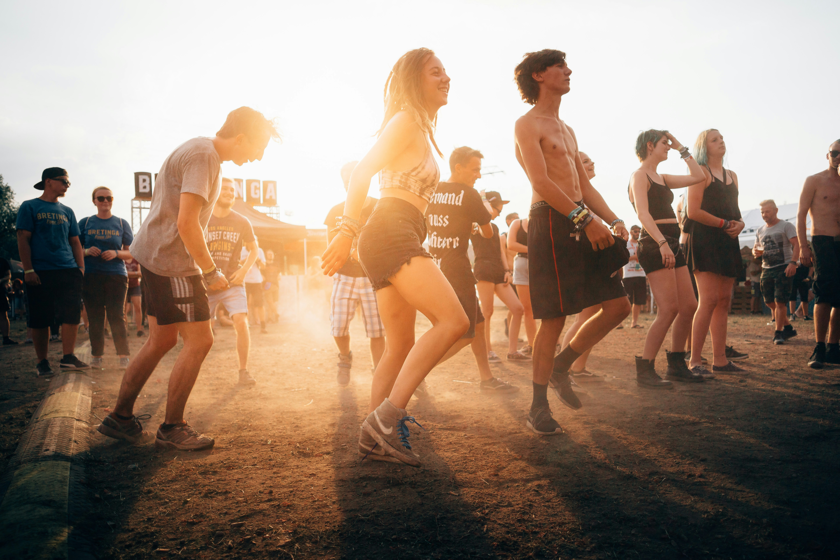There are gestures that define us as a species, and dance is one of them. When everything fails, the body continues to speak: it is stirred, it shakes, it is released. Barbara Ehrenreich documented him in ‘Dancing in the Streets’, where he shows how dance has historically served as collective response to pain. Today, that instinct seems to wake up again, in a world worn by stress, uncertainty and isolation.
Decoding the rave. In warehouses, parks, coffees and even luxury resorts, the raves of the 21st century no longer revolve exclusively around alcohol, strobe lights and early morning. Now they can also start with a yoga session at dawn, include substance -free spaces, foster deep conversations and offer coffee instead of cocktails.
In an article for Marie Claire, they explain that the phenomenon is spreading in many countries and electronic music remains the central beat. However, the purpose has changed: it is about reconnecting with the body, with others and with oneself. “We are very connected online, but possibly more disconnected in real life,” says Kesang Ball, co -founder of Trippin in the middle, a global platform of young culture. “People yearn for spaces where they can meet related people.”
A cultural change. It might seem like a whim, since raves have always been a countercultural space that gave a room for response to what happened at the time. However, as the fashion magazine addresses, the need for this new movement revolves around postpandemic emotional exhaustion, the epidemic of solitude, the collapse of mental well -being and the fed up in front of a digital life that promised connection, but left empty.
In Spain, the average time that users dedicate to social networks is 1 hour and 55 minutes a day, according to a thirteen study. In this context, the holidays are not just parties: they are spaces where they relear to be with others without screens in between.
Even deeper. This turn also reflects a generational sensitivity. Unlike the millennial stereotype of the party until dawn, generation Z prioritizes self -care, authenticity and mental health. Excess, blackout and hangover have ceased to be gestures of rebellion; Today, the subversive is to stay lucid, connect deeply and find pleasure without guilt. In this context, the Rave does not disappear, it transforms.
In fact, an investigation from the University of Leeds, Exploring Relationships Between Electronic Dance Music Evention and Well-Being, He found that attending electronic music events is directly associated with greater psychological, emotional and social well -being. In the study they identified that Raves attendees experienced deep feelings of connection, individual expression, community and collective euphoria.
And not a drop of alcohol. Sobriety is a trend, the youngest are changing the Cup for the espresso. The calls coffee raves “Morning fiests in cafeteria converted into clubs,” they are just an example of paradigm shift.
From the track to inner peace. The change has been progressive, but firm. In a report on the EDM page they have chatted with groups such as Daybreaker, Superbloom or The Oracle Project that are at the forefront of a new era of parties: daytime, conscious and community. In them, dance and care for themselves are not opposite actions. Lauren Branc, founder of The Oracle Projectsummarizes it like this: “I did not want to give up the fun to leave, but neither did I want to continue revolving around something that became ill and does not encourage a deep connection.”
The movement also has its luxury expression. As detailed in Travel and Leisure, in Koh Samui, the W hotel organizes musical retreats where emerging DJs such as Joplin share a poster with sessions of Sound Healing and Yoga, in a five -star environment. There, electronic music does not compete with rest, but is synchronized with it. Although it is not the only space, because in coffee shops such as Santanera Coffee in Madrid or Vera Café in Barcelona, the coffee parties They gather hundreds of young people who dance to the rhythm of the house and the techno with cappuccino in hand. Everything, in broad daylight.
A radical act: dance in community. The new Rave culture is not a nostalgic copy of the past. It is a reinvention. Faced with a world that commercializes time, crushes joy and fragments the sense of belonging, dance together – without filters or screens – can be a deeply radical act. Rob Glassett, known as Fold, summarizes it clearly for Marie Claire: “The dance clues have always been important places to disconnect … but not to get stuck, but to reconnect.”
In an era saturated with stimuli and algorithms, returning to the body, to rhythm and human contact can be more revolutionary than it seems. And yes, as the DJ says Surusinghe in the fashion magazine: “Music has a power comparable to that of religion,” then the dance floor is, perhaps, one of the last truly free sanctuaries.
Image | Unspash
WorldOfSoftware | Instead of a cubata, a capuchino: the triumph of the daytime raves where the raveros consume coffee instead of alcohol










